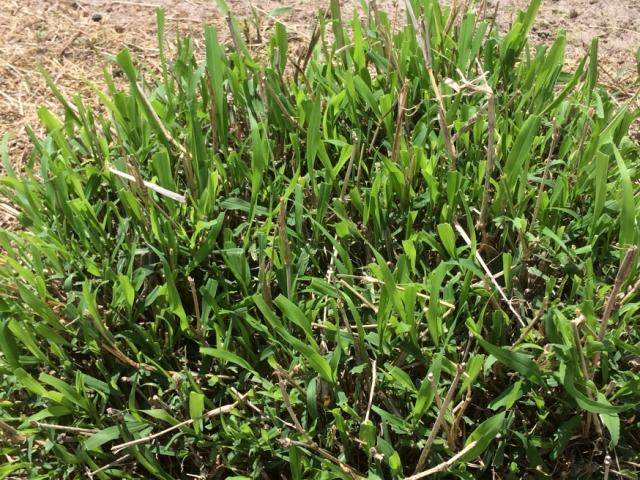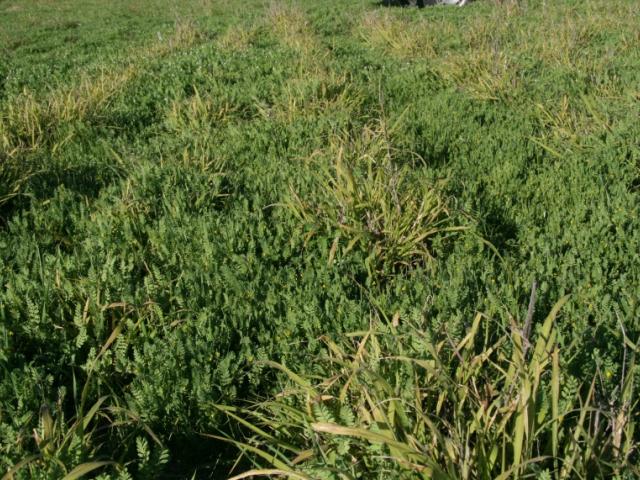Features
- tufted, highly palatable, leafy grass
- moderate to high drought tolerance with excellent persistence through extended dry periods
- good spring growth
- able to quickly respond to rain, even after extended hot, dry periods
- requires fertile conditions for good performance
- well adapted to sandy soils in northern agricultural region and on south coast
- does not tolerate waterlogging or flooding.
Background
The panic grasses (Megathyrsus maximus formerly Panicum maximum) are one of the major sown sub-tropical grasses and are widely used in South America, Japan, and India as well as eastern Australia. M. maximus is a diverse species as it includes both the tall (up to 4 metres) tropical Guinea grasses and the shorter sub-tropical panic grasses which are the type of interest for southern WA.
Panic grasses have demonstrated good potential in both the northern agricultural region and south coast of WA, with excellent persistence through extended dry periods and high production when conditions are favourable. They are palatable, well received by cattle and sheep and often preferentially grazed. They have been widely sown in the NAR (>60 000 hectares) and the area of suitable soils is >900 000 hectares (ha), while on the south coast there are relatively few commercial paddocks, but the potential area is >500 000ha.
Description
- moderately tall, leafy, tufted grass (0.8-1.8 metres)
- leaf sheath is often hairy
- flower heads are an open, branched panicle.
Seasonal growth pattern
The panic grasses have a similar growth pattern to the other warm season grasses. They respond rapidly to out-of-season rainfall including light showers and also after rain in autumn when the temperatures are mild to warm. There can be moderate growth in early winter when the prevailing weather conditions are mild, otherwise with cool conditions and frosts during winter they are essentially dormant. The panic grasses are one of the first sub-tropical grasses to start growing in spring when the temperatures increase. They will continue growing until soil moisture is depleted, then opportunistically over summer and after the rains in autumn.
Like most sub-tropical grasses, panic grasses prefer high temperatures with maximum growth at 30-36°C/25-31°C (day/night temperature) under controlled conditions. The growth rate falls sharply when the temperature is below 18°C/13°C, with negligible growth below 15°C/10°C.
| Rainfall (estimated minimum) | >425 millimetres (mm) (>400mm south coast) |
|---|---|
| Drought tolerance | Moderate to high |
| Frost tolerance | Low (persistence adversely affected by combination of cold, wet soils) |
| Soil type | Range of soils, but prefers well drained, fertile loams. In WA has performed well on coarse-textured soils, including deep white sands |
| Soil fertility requirements | Moderate to high |
| Soil pHCa | >4.3 (est.) |
| Aluminium tolerance | Good |
| Waterlogging tolerance | Low |
| Salt tolerance | Nil |
| Ability to spread naturally | Low (can have recruitment in low density stands) |
| Dry matter digestibility | Av. 65% (range 57-72%) |
| Crude protein | Av. 11.2% (Feedipedia) varies with age of regrowth and N nutrition |
Establishment
The panic grasses have very small seeds (1.2 million/kilogram) that must be sown shallow (5-10mm) with good seed-soil contact. Sow 2-5 kilograms/hectare (kg/ha) of good quality seed when sown alone or 1-3kg/ha when sown in a mixture (for coated seed use the higher seeding rates). The seed requires contact with moist soil for three days to germinate. For a perennial grass the seedlings have relatively good vigour, but require 100% weed control — refer to Sub-tropical grass establishment webpage.
Panic grass has post-harvest seed dormancy for a period of 6-8 months after harvest. Commercial seed quality can be an issue as seed quality varies widely and some seed coming into WA has high levels of post-harvest seed dormancy. Most of the sub-tropical grass seed is harvested in north Queensland and the harvest window is January to April, so seed harvested in March-April can still have high levels of seed dormancy in August-September.
The recommendation is to obtain a copy of the ‘seed certificate’ which is usually issued within a few weeks of harvest (i.e. can then estimate harvest time). Fresh seed on the seed certificate equates to dormant seed. The germination tests for bare panic grass seed use a solution containing a plant growth regulator (e.g. ethanol) which is partially effective in breaking dormancy. On the other hand, germination tests for coated panic grass seed use water.
Livestock disorders
Panic grass contains low to moderate levels of oxalate (0.52% summer, 0.80% autumn) which can result in big head in horses and occasionally nephrosis or hypocalcaemia in ruminants.
Panic grass can contain steroidal saponins (protodioscin) which can cause secondary photosensitisation in stock. Reports from Queensland suggest it is more likely to occur when the grass is young or growing rapidly after a dry spell, with young stock (especially sheep) and when the stock are in a stressed condition. In WA a survey of commercial paddocks collected ~100 panic grass samples over a 12 month period. Three samples had saponin concentrations just above the critical value, while the remainder had low to non-quantifiable concentrations.
For existing perennial grass-based pastures, producers need to be vigilant when grazing livestock on pastures containing significant amounts of both signal and panic grasses. The risk of secondary photosensitisation is heightened when the perennial grasses represent all or most of the palatable green feed on offer (FOO). For paddocks containing panic grass, but no signal grass, the risk of photosensitisation is considered minimal. Nevertheless, producers need to monitor stock regularly when the panic grass represents all or most of the palatable green FOO.
Management
In the first year, the pasture should not be grazed until the plants have developed crowns, have set some seed and/or are well anchored. A light grazing over the first summer will encourage the plants to tiller, but they need to be well anchored (test by giving plants a short, strong pull to mimic grazing) or long-term damage to the stand can occur.
Panic grasses are very palatable and often preferentially grazed in mixed swards. However, they are not tolerant of heavy grazing and require some form of rotational grazing.
A useful strategy to help protect the panic grasses from over-grazing is to have a ‘stubble’ of old stems 10-15 centimetres (cm) in height to prevent cattle or sheep from grazing the crown down to ground-level when there is limited green, palatable FOO. Continued grazing of fresh growth will gradually result in the death of tillers and eventually the death of plants. Signs of over-grazing include plant crowns grazed to ground-level, often accompanied by the presence of dead tillers and the centre of the crown may be dead. To develop this ‘stubble’, allow the plants to grow out and set seed then either graze the plants back down to 10-15cm or mow the paddock.
The best strategy is to avoid over-grazing. However, the good news is that panic grass pastures which have been over-grazed can be rejuvenated by resting the paddock for a period of 3-6 months under favourable growing conditions e.g. following useful out-of-season rainfall or in spring to early summer. There are a number of commercial paddocks that have been successfully rejuvenated with a strategic rest, when it appeared the paddock may need to be re-seeded.

Typically livestock grazing panic grass will maintain or gain liveweight at a modest rate. A high nutritive value companion species or a feed supplement is required to grow stock at high growth rates.
Panic grass-based pastures have been successfully pasture cropped, in particular with barley and narrow-leaf lupins.
Companion species
In the northern agricultural region, panic grasses are usually sown in a mix with Rhodes grass, although some growers are sowing only panic grass or panic grass dominant mixtures. Panic grass is both more palatable and also more persistent under stressful environmental conditions than Rhodes grass. The main issue with sowing only panic grass is that good, uniform establishment at the paddock-scale is essential. If establishment of panic grass is sub-optimal when sown as a mixture, then Rhodes grass can fill in the gaps through its stoloniferous growth. Panic grass can be preferentially grazed by stock, so the pasture needs to be grazed while the Rhodes grass is still palatable - occasional slashing or mowing may be required to remove patches of Rhodes grass with rank growth.
While there is only a limited area sown to panic grasses on the south coast most producers have sown panic grass alone (rather than in a mixture with Rhodes grass). To date, this approach has been successful and together with the fact that Rhodes grass does not perform as well as panic grass we recommend sowing panic alone on the south coast.
Panic grass is compatible with a range of annual legumes depending on the soil type, including French and yellow serradella on sandy soils. Refer to page Companion legume options for sub-tropical grasses.
Cultivars
There are four main commercial varieties, including two recently released varieties especially developed for southern Australia; Megamax™059 and Megamax™049.
‘Megamax™059’ is a new variety of panic grass selected in Australia by the Future Farm Industries Cooperative Research Centre (CRC), the Department of Agriculture and Food, Western Australia (DAFWA) and the New South Wales Department of Primary Industries (NSW DPI). It was selected for superior growth characteristics including increased production, high persistence and cool season tolerance in comparison to other commercial sub-tropical grass cultivars.
Megamax™059 is a medium to large panic grass, medium-leafed with a similar tiller density to Gatton panic. It originates from South Africa. In WA, Megamax™059 has demonstrated very good persistence and biomass production (Table 2).
‘Megamax™049’ is a new variety of panic grass selected in Australia by the Future Farm Industries CRC, DAFWA and the NSW DPI for superior growth characteristics including increased production, high persistence and cool season tolerance in comparison to other commercial sub-tropical grass cultivars.
Megamax™049 is a short to medium panic, the foliage is soft and fine-leafed with excellent leafiness and a medium to high tiller density. It originates from a region in Africa where the average rainfall is 450mm and there are extended dry periods. It is early flowering with fine stems. In WA, Megamax™049 has demonstrated excellent persistence and very good biomass production (Table 2).
| Variety | Average frequency % (groundcover) | Biomass as % of Gatton panic |
|---|---|---|
| MegamaxTM049 | 45.6 | 118 |
| MegamaxTM059 | 39.2 | 116 |
| Gatton control | 38.8 | 100 |
| Green panic control | 37.2 | 113 |
‘Gatton’ panic (public variety) originates from Zimbabwe and is a robust, tufted grass that is agronomically similar to green panic, slightly less drought-tolerant and more sensitive to frosts, but superior on low fertility soils. Gatton panic has longer and broader leaves than green panic, with a more prominent midrib, finely pubescent leaf sheaths, greener foliage and often contains anthocyanins (purple pigmentation) near the base of the stems.
‘Green panic’ (or ‘Petrie’) (public variety) is an erect, tall (seed heads up to 1.8 metres), tufted grass which is distinguished from Gatton panic by its light-green foliage, the lower surface of its leaves and its leaf sheaths have sparse, long hairs (compared with short down-like hairs) and the leaf midrib is less pronounced. It is not widely grown in WA and in local replicated field trials biomass production was good, but it was not utilised as well as it contains a higher proportion of stem compared with leaf. It also has low frost tolerance.
Acknowledgements
The development of the new Megamax panic grasses was co-funded by DAFWA, the Future Farm Industries CRC, Meat and Livestock Australia (MLA) and NSW DPI with commercialisation through Heritage Seeds.


